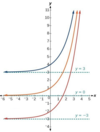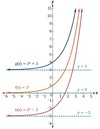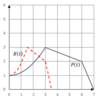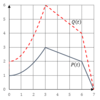Transformations Flashcards
(15 cards)
What are shifting in functions, and how do they work?
Shifting is when a function is affected by a ADDING OR SUBTRACTING value/s.
Depending on the value’s position in the equation, it will either shift vertically or horizontally.
What is a Vertical Reflection?
A vertical reflection happens when the whole function becomes negative. An example would be if the function is f(x)=x2+7 then the vertical reflection would be g(x)=-(x2+7)
What is a horizontal Reflection?
A horizontal reflection (left/right) happens when just the x-part of function becomes negative.
An example if the function was f(x)= x2+7 the function when reflected would be g(x)= f(-x)=(-x)2+7.
What is a Horizontal stretch?
A horizontal stretch happens when a value multiplies by the X in a function. An example of this is g(x)=f(2x) (keep in mind it can be multiplied by a fraction)
Remember that the scale factor is what the coordinates are multiplied by, but inside of the function, it’ll be upside-down.
What is a Vertical stretch?
A vertical stretch (up/down) happens when a value multiplies a whole function. An example of this is g(x)= 2f(x) (keep in mind it can be multiplied by a fraction)
How do you have to change the function “f(x)” if you want to shift it horizontally? (For example, to the right by 3 or by the left by 3.)

You put a “-h” in with the x term.
f(x)=2x
g(x)=f(x+3)=2x+3
h(x)=f(x-3)=2x-3

How do you have to change the function “f(x)” if you want to shift it vertically? (For example, up or down by 3.)

You put a “+k” at the end.
f(x)=2x
g(x)=f(x)+3=2x+3
h(x)=f(x)-3=2x-3

How do you have to change the function “f(x)” if you want to reflect it in the x-axis (aka “vertically”)?

You multiply the whole function by -1.
The new function is -f(x).

How do you have to change the function “f(x)” if you want to reflect it in the y-axis (aka “horizontally”)?

You multiply the x-part by -1.
The new function is f(-x).

How do you have to change the function “f(x)” if you want to stretch it vertically by a scale factor “a”?

You multiply the whole function by a.
If a is bigger than 1, it’s going to stretch the function so that it’s taller.
If a is smaller than 1, it’s going to compress the function so that it’s shorter.

How do you have to change the function “f(x)” if you want to stretch it horizontally by a scale factor of “b”?

You multiply the whole x-part by 1/b. (Be careful that you first factor b out of a horizontal shift, if necessary.)

Where is the vertex and line of symmetry for
f(x)=a(b(x-h)2)+k?

Vertex: (h, k)
Line of symmetry: x=h

How would you describe the transformation from P(t) to R(t)?

This is a horizontal stretch with a scale factor of 1/2. (Notice that each point of R is half as far from the axis as P.)
So R(t)=P(2t)

How would you describe the transformation from P(t) to Q(t)?

This is a vertical stretch with a scale factor of 2. (Notice that each point of Q is twice as far from the axis as P.)
So Q(t)=2P(t)

What type of transformation does the following function represent?
f(x)=(x-2)2+2
It translates the x2 function to the right by 2 and up by 2.



